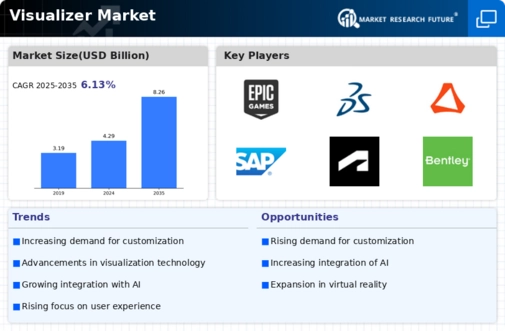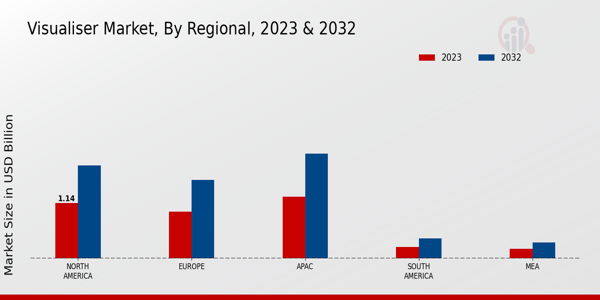Market Trends and Growth Projections
The Global Visualizer Market Industry is characterized by several key trends and growth projections. The market is expected to reach 4.29 USD Billion in 2024 and is projected to grow to 8.26 USD Billion by 2035. This growth trajectory indicates a compound annual growth rate of 6.13% from 2025 to 2035. The increasing demand for data visualization tools across various sectors, coupled with advancements in technology, is likely to drive this growth. Additionally, the rising adoption of cloud-based solutions and the emphasis on business intelligence will further contribute to the expansion of the market.
Rising Adoption of Cloud-Based Solutions
The shift towards cloud-based solutions is transforming the Global Visualizer Market Industry. Businesses are increasingly adopting cloud technologies to facilitate remote access to visualization tools, thereby enhancing collaboration among teams. This trend is particularly relevant in a globalized economy where remote work is becoming the norm. Cloud-based visualization platforms offer scalability and flexibility, allowing organizations to adapt their data visualization needs as they grow. As a result, the market is poised for substantial growth, with a projected compound annual growth rate of 6.13% from 2025 to 2035. This growth reflects the increasing preference for cloud solutions in data analytics.
Growing Demand for Data Visualization Tools
The Global Visualizer Market Industry experiences a notable surge in demand for data visualization tools. Organizations across various sectors increasingly recognize the importance of data-driven decision-making. As a result, the market is projected to reach 4.29 USD Billion in 2024, reflecting a growing reliance on visual analytics to interpret complex data sets. This trend is particularly evident in sectors such as finance and healthcare, where real-time data visualization enhances operational efficiency and strategic planning. The ability to present data visually allows stakeholders to grasp insights quickly, thereby fostering a culture of informed decision-making.
Emphasis on Business Intelligence and Analytics
The emphasis on business intelligence and analytics is a significant driver of the Global Visualizer Market Industry. Companies are increasingly investing in analytics tools to gain insights into customer behavior, market trends, and operational efficiencies. This trend is evident in various industries, including retail and manufacturing, where data visualization aids in identifying opportunities for improvement. The growing recognition of the value of data analytics is likely to propel the market forward, as organizations seek to harness the power of visualization to drive strategic initiatives. As the industry evolves, the demand for advanced visualization tools is expected to rise, further fueling market growth.
Regulatory Compliance and Reporting Requirements
Regulatory compliance and reporting requirements are becoming increasingly stringent across industries, thereby influencing the Global Visualizer Market Industry. Organizations are required to present data in a clear and comprehensible manner to meet compliance standards. This necessity drives the demand for visualization tools that can effectively communicate complex information to stakeholders. Industries such as finance and healthcare are particularly affected, as they must adhere to strict reporting guidelines. Consequently, the market for visualization tools is likely to expand as companies invest in solutions that facilitate compliance while enhancing transparency and accountability in their reporting processes.
Technological Advancements in Visualization Software
Technological innovations play a pivotal role in shaping the Global Visualizer Market Industry. The integration of artificial intelligence and machine learning into visualization software enhances the capabilities of these tools, enabling users to generate more sophisticated visual representations of data. For instance, advanced algorithms can identify patterns and trends that may not be immediately apparent. This evolution is likely to attract a broader user base, including small and medium enterprises that seek to leverage data visualization for competitive advantage. As the software continues to evolve, the market is expected to grow significantly, with projections indicating a value of 8.26 USD Billion by 2035.













